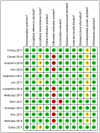Meta-analysis of gadoxetic acid disodium (Gd-EOB-DTPA)-enhanced magnetic resonance imaging for the detection of liver metastases
- PMID: 23144927
- PMCID: PMC3492464
- DOI: 10.1371/journal.pone.0048681
Meta-analysis of gadoxetic acid disodium (Gd-EOB-DTPA)-enhanced magnetic resonance imaging for the detection of liver metastases
Abstract
Objective: To determine the accuracy of MR imaging with Gd-EOB-DTPA for the detection of liver metastases.
Materials and methods: PUBMED, EMBASE, the Web of Science, and the Cochrane Library were searched for original articles published prior to February 2012. The criteria for the inclusion of articles were as follows: reported in the English language; MR imaging with Gd-EOB-DTPA was performed to detect liver metastases; histopathologic analysis (surgery, biopsy), intraoperative observation (manual palpatation, intraoperative ultrasonography), and/or follow-up US was the reference standard; and data were sufficient for the calculation of true-positive or false-negative values. The methodological quality was assessed by using the quality assessment of diagnostic studies instrument. The data were extracted to calculate sensitivity, specificity, predictive value, diagnostic odds ratio, and areas under hierarchical summary receiver operating characteristic (HSROC) curve to perform heterogeneity test and threshold effect test, as well as publication bias analysis and subgroup analyses.
Results: From 229 citations, 13 were included in the meta-analysis with a total of 1900 lesions. We detected heterogeneity between studies and evidence of publication bias. The methodological quality was moderate. The pooled weighted sensitivity with a corresponding 95% confidence interval (CI) was 0.93 (95% CI: 0.90, 0. 95), the specificity was 0.95 (95% CI: 0.91, 0.97), the positive likelihood ratio was 18.07 (95% CI: 10.52, 31.04), the negative likelihood ratio was 0.07 (95% CI: 0.05, 0.10), and the diagnostic odds ratio was 249.81 (95% CI: 125.12, 498.74). The area under the receiver operator characteristic curve was 0.98 (95% CI: 0.96, 0.99).
Conclusion: MR imaging with Gd-EOB-DTPA is a reliable, non-invasive, and no-radiation-exposure imaging modality with a high sensitivity and specificity for detection of liver metastases. Nonetheless, it should be applied cautiously, and large scale, well-designed trials are necessary to assess its clinical value.
Conflict of interest statement
Figures





Similar articles
-
Gadoxetic acid disodium-enhanced magnetic resonance imaging for the detection of hepatocellular carcinoma: a meta-analysis.PLoS One. 2013 Aug 15;8(8):e70896. doi: 10.1371/journal.pone.0070896. eCollection 2013. PLoS One. 2013. PMID: 23967130 Free PMC article.
-
Combined Application of Gadoxetic Acid Disodium-Enhanced Magnetic Resonance Imaging (MRI) and Diffusion-Weighted Imaging (DWI) in the Diagnosis of Chronic Liver Disease-Induced Hepatocellular Carcinoma: A Meta-Analysis.PLoS One. 2015 Dec 2;10(12):e0144247. doi: 10.1371/journal.pone.0144247. eCollection 2015. PLoS One. 2015. PMID: 26629904 Free PMC article.
-
Magnetic resonance imaging with gadoxetic acid disodium for the detection of hepatocellular carcinoma: a meta-analysis of 18 studies.Acad Radiol. 2014 Dec;21(12):1603-13. doi: 10.1016/j.acra.2014.08.003. Epub 2014 Sep 26. Acad Radiol. 2014. PMID: 25262955
-
Is Gadoxetic Acid Disodium (Gd-EOB-DTPA)-Enhanced Magnetic Resonance Imaging an Accurate Diagnostic Method for Hepatocellular Carcinoma? A Systematic Review with Meta-Analysis.Curr Med Imaging. 2022;18(6):633-647. doi: 10.2174/1573405617666210917124404. Curr Med Imaging. 2022. PMID: 34533447
-
Predictive value of Gd-EOB-DTPA -enhanced magnetic resonance imaging for post-hepatectomy liver failure: a systematic review and meta-analysis.Acta Radiol. 2023 Apr;64(4):1347-1356. doi: 10.1177/02841851221134485. Epub 2022 Oct 27. Acta Radiol. 2023. PMID: 36303435
Cited by
-
Gd-EOB-DTPA-Enhanced MRI for Detection of Liver Metastases from Colorectal Cancer: A Surgeon's Perspective!Int J Hepatol. 2013;2013:572307. doi: 10.1155/2013/572307. Epub 2013 Apr 9. Int J Hepatol. 2013. PMID: 23653860 Free PMC article.
-
Clinical impact of preoperative liver MRI in the evaluation of synchronous liver metastasis of colon cancer.Eur Radiol. 2018 Oct;28(10):4234-4242. doi: 10.1007/s00330-018-5422-2. Epub 2018 Apr 24. Eur Radiol. 2018. PMID: 29691635
-
Clinical Significance of Liver MR Imaging.Magn Reson Med Sci. 2023 Apr 1;22(2):157-175. doi: 10.2463/mrms.rev.2022-0100. Epub 2023 Feb 1. Magn Reson Med Sci. 2023. PMID: 36725068 Free PMC article. Review.
-
Re-evaluation of detectability of liver metastases by contrast-enhanced CT: added value of hepatic arterial phase imaging.Jpn J Radiol. 2014 Aug;32(8):467-75. doi: 10.1007/s11604-014-0331-z. Epub 2014 May 23. Jpn J Radiol. 2014. PMID: 24854901
-
Added Value of Liver MRI in Patients Eligible for Surgical Resection or Ablation of Colorectal Liver Metastases Based on CT: A Systematic Review and Meta-Analysis.Ann Surg Open. 2024 Mar 18;5(1):e401. doi: 10.1097/AS9.0000000000000401. eCollection 2024 Mar. Ann Surg Open. 2024. PMID: 38883954 Free PMC article.
References
-
- Centeno BA (2006) Pathology of liver metastases. Cancer Control 13: 13–26. - PubMed
-
- Kokudo N, Tada K, Seki M, Ohta H, Azekura K, et al. (2001) Anatomical major resection versus nonanatomical limited resection for liver metastases from colorectal carcinoma. Am J Surg 181: 153–159. - PubMed
-
- Motosugi U, Ichikawa T, Sou H, Sano K, Tominaga L, et al. (2010) Distinguishing hypervascular pseudolesions of the liver from hypervascular hepatocellular carcinomas with gadoxetic acid-enhanced MR imaging. Radiology 256: 151–158. - PubMed
-
- Hamm B, Staks T, Muhler A, Bollow M, Taupitz M, et al. (1995) Phase I clinical evaluation of Gd-EOB-DTPA as a hepatobiliary MR contrast agent: safety, pharmacokinetics, and MR imaging. Radiology 195: 785–792. - PubMed
Publication types
MeSH terms
Substances
LinkOut - more resources
Full Text Sources
Medical

